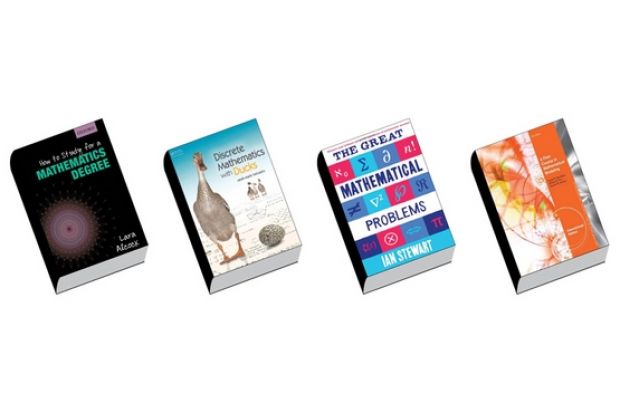Why must I read a book? I’m studying maths, not English!” was the anguished response from a first-year student tasked with writing a review of a popular mathematics book in an assignment intended to broaden students’ mathematics knowledge.
Mathematics textbooks are not usually page-turners, and they rarely excite new undergraduates. Indeed Lara Alcock, author of How to Study for a Mathematics Degree, confesses that it was not until the end of her first year as an undergraduate that she began to read and appreciate her maths textbooks. And yet we encourage students to buy expensive books, hoping that some will at least open them and perhaps even make good use of them. Accordingly, it is well worth looking at some recent titles aimed at new maths undergraduates that are likely to be read rather than simply gather dust.
Discrete Mathematics with Ducks (Belcastro) boasts an attention-catching title and is designed to be used either by a lecturer teaching this branch of the first-year curriculum or by a student for self-study. It contains helpful hints on how to read and use textbooks, but its selling point is the amusing “duck” examples and “duck” annotations that break up the text and enhance its readability. The instructors’ preface explains how the exercises can be used in group work as well as independent study. The book comes with a host of links to a variety of resources: GeoGebra files for interactive computer graphics, interesting articles from sources such as the MacTutor History of Mathematics website, various mathematical puzzles and applets so that readers can explore the mathematical algorithms, and a downloadable version of Donald Knuth’s stimulating paper “The Computer as Master Mind”. Anyone teaching discrete mathematics should investigate this student-friendly book.
Another text with the potential to enliven lectures and engage kinaesthetic learners is the second edition of Hull’s Project Origami: Activities for Exploring Mathematics. It covers areas such as graph theory and abstract algebra, as well as the more expected subjects of geometry and topology, and offers origami activities that can be carried out to provide further insight into the topics, along with useful indexes of puzzles and the subjects covered. While these ideas would enhance the teaching of these topics, academics will also find them helpful for outreach activities to inspire potential students.
Our department’s book review assignment encourages new undergraduates to read maths books and to make more use of library facilities. We provide a number of suggestions, including Rob Eastaway and John Haigh’s The Hidden Mathematics of Sport and Marcus du Sautoy’s The Number Mysteries, and next year’s list will see the addition of Ian Stewart’s The Great Mathematical Problems. Although Stewart’s book is rather thicker than some of his others, it will appeal to the serious mathematics students looking to gain more knowledge and understanding of historic problems ranging from the pure mathematics of Goldbach’s conjecture to applications such as the “three-body problem”. As you would expect, it is engaging and readable while communicating serious mathematics: Stewart has a rare gift for presenting deep mathematics accessibly while making no concessions to dumbing down.
Another book that we will be strongly recommending to first-years is the aforementioned How to Study for a Mathematics Degree. This practical book has two halves. The first, designed to prepare students for university mathematics, looks at topics such as proof, the concept of definitions and theorems and abstract mathematics, while the second part deals with the study skills necessary for learning mathematics at university. It offers general advice that students would do well to heed: including “how to address your lecturer by email”, “what to bring to maths help sessions” and “why you should turn up to lectures”. Many lecturers will, I am sure, recognise their own words in this section, including lines such as “students who consistently attend lectures do better than those who don’t”.
There is a helpful section for students who become discouraged when they arrive at university and find that they are no longer top of the class as they were at school, and thus lose confidence in their mathematical ability. This is a problem many students face but do not feel able to discuss, and Alcock’s advice is valuable.
My dilemma regarding this book is whether I would want students to read it before they arrive at university or during their first year. This will depend in part on the content of the degree course and whether or not you think students straight from A level will be put off by reading about definitions, proofs and theorems before university. However, this book fills a gap: maths students sometimes find that guides to succeeding at university, like the excellent How to Get a Good Degree (Race), are insufficiently subject-specific. Alcock’s work will definitely join my list of recommended books for maths undergraduates during their first year, along with favourite old-timers such as Pólya’s How to Solve It and Mason et al’s Thinking Mathematically.
Other recommended new titles include A First Course in Mathematical Modeling (Giordano et al) and A Primer on Scientific Programming with Python (Langtangen). For more advanced students and for information about important new applications of maths, Mathematical Tools for Understanding Infectious Disease Dynamics (Diekmann et al), Statistical Models in Epidemiology (Clayton and Hills) and Statistics: Unlocking the Power of Data (Lock et al) are worth investigating.
Tap and scroll down for links to all Mathematics textbooks
Or view PDF below
Register to continue
Why register?
- Registration is free and only takes a moment
- Once registered, you can read 3 articles a month
- Sign up for our newsletter
Subscribe
Or subscribe for unlimited access to:
- Unlimited access to news, views, insights & reviews
- Digital editions
- Digital access to THE’s university and college rankings analysis
Already registered or a current subscriber? Login
